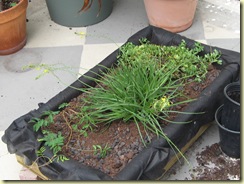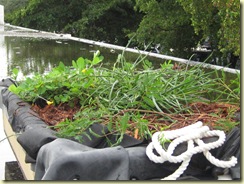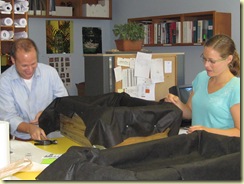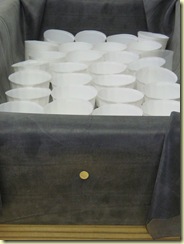The first test strip is a month old! The month of August was gentler than usual in South Florida, many days were around 70, with a few scorchers on the roof at 120 degrees. We had over 12" of rain. Not a bad month for a test strip and it is thriving. The drip system is in place for use during drought periods.
Tuesday, September 16, 2008
Monday, September 15, 2008
Jurisdictional Agencies Meet to Consider Credits for Sustainable Stormwater Management
![]() South Florida Water Management and DEP are among jurisdictional agencies meeting in Orlando today to develop new laws regarding sustainable solutions for storm water management including practices encouraged by Low Impact Development. Low Impact Development includes stormwater and land development strategies that emphasize conservation and use of on-site natural features integrated with, small scale hydrologic controls in an effort to mimic predevelopment hydrologic conditions. Practices include minimizing impervious area and compaction, rainwater harvesting, permeable surfaces, depression storage, bio retention, soil filtration, vegetated swales, enhanced stormwater ponds and green roofs. Retain, Detain, Recharge, Filter and Use!
South Florida Water Management and DEP are among jurisdictional agencies meeting in Orlando today to develop new laws regarding sustainable solutions for storm water management including practices encouraged by Low Impact Development. Low Impact Development includes stormwater and land development strategies that emphasize conservation and use of on-site natural features integrated with, small scale hydrologic controls in an effort to mimic predevelopment hydrologic conditions. Practices include minimizing impervious area and compaction, rainwater harvesting, permeable surfaces, depression storage, bio retention, soil filtration, vegetated swales, enhanced stormwater ponds and green roofs. Retain, Detain, Recharge, Filter and Use!
Saturday, September 6, 2008
Project Test Strips
On August 8th we planted the first of what we hope will be a series of test strips experimenting with different recipes to determine the best plants, planting media, planting methods and maintenance activities for green roofs in South Florida. 
We are not testing the layering system, waterproofing etc. We are using the easiest construction methods and least expensive materials for the trays and layering system because of budget constraints. The trays are made of pressure treated pine. (cost not weight consideration) The tray is lined with pond liner. A layer of “cups” approximately 2" deep are laid out on the pond liner to mimic commercial drainage systems that get water out of the planting media yet store it for future use. We made this layer out of recycled soda cups. This layer is protected by a filter fabric. The planting media goes on top of this.
The layering system loosely resembles what has been developed by others, commercial green roof providers and the system designed by John Szerdi at the Eco-Centre in Lake Worth.
We are planning to start with two test strips and would like to add more as time and money allow. Only one has been installed so far.
These are the parameters of the test:
Two trays 30” x 30”
One tray will have a 3” planting media depth.
One tray will have an 8” planting media depth
We will plant a mixture of plants in both trays
The 3” tray will have spreading ground covers: Bulbine, Mimosa Strigulosa, Perennial Peanut
The 8” tray will have a mixture of grasses: Wiregrass, Equisetum, Muhlie Grass
Some wildflower seeds will be mixed in with the grasses, just to see what happens: Greeneyes, Gallardia, Coreopsis. These were recommended by the Florida Wildflower Coop.
Both trays will have the same planting media:
50% black lava rock mixed with 50% Canadian peat topped with 1” shredded eucalyptus mulch.
We will ensure that the strips get water, at a minimum, once every three days through an establishment period of one month. After that month, the strips will only be watered if there is less than 1” of rain over a period of 10 days.
We will take pictures of the plants once a month and post them on the blog.
After three years, we will pull the plants to examine their root mass.
These are our assumptions:
Soil mix: We wanted to develop a mix that would be light, drain well and have a little bit of organic material. The lighter colored mulch on top will keep the planting media cooler and retail some water. The black lava rock will have a better ph than red lava rock.
Plant choices were made from our experiences with plants in South Florida. We wanted to use plants that could take very wet or dry conditions in case the tray became flooded over a period of South Florida rainy days. We feel that a mixture of plants is better than a mono culture. Our plant selections are not all native but are selected because we have found that they are very tough and adapt to wet or dry conditions.
We used “trays” for several reasons. We did not have a location to do a full out extensive green roof directly on the roof membrane. Many people feel that trays won’t work in South Florida because they’ll blow off in a hurricane. There are two ways that wind can be approached. The first is to make the “planters” weighty enough to resist hurricane force winds as John Szerdi did at the Eco-Centre. The second is to secure lighter trays to the roof securely enough to resist uplift. We developed one detail for this with Botkins and Parssi for a penthouse garden in Palm Beach and have some alternative attachments that we would like to test in the future. For this project we plan just to put the tray on the roof and remove them when necessary.
Another reason I wanted to experiment with trays is because I’m concerned about what will happen when plant roots make an extensive roof “root bound” over a period of time. Since plants don’t go dormant in South Florida, will the roots take over within 5-10 years? Would the whole roof have to be replanted over a period of time? Or would it be easier to switch trays out? Or, are there plants that wouldn’t develop much of a root system and still survive?
This is our hypothesis:
The plants we have picked are survivors.
After three years, the roots the tray will be ‘root bound’ to a point that it would jeopardize plant health in the following year. The implication of this would be that it would be best to use trays that can be switched out or a plan to replant the roof after 3-4 years.
Potential future test strips:
Dune plants – will they be able to take inundation of several rainy days?
Lighter colored lava rock no mulch – determine weight savings, does ph matter?
Mono cultures (all one type of plant)
Parallel trays that aren’t disassembled after 3 years to see how much longer the plants survive.
Do you have any other ideas?
Please let us know what you think of our assumptions and the way we have set the test up.
Sprout!
Tuesday, September 2, 2008
Don't Call it Dirt!
![]() If you go to one of the excellent classes provided by Green Roof for Healthy Cities, a point that is emphasized is that green roof plants are planted in planting media and not soil or dirt. Why? Most green roof applications are concerned about water retention and weight. Organic matter has a tendency to hold onto water and weigh more, depending on its actual composition. Therefore it is of greatest importance that the planting media is carefully thought out, specified and installed.
If you go to one of the excellent classes provided by Green Roof for Healthy Cities, a point that is emphasized is that green roof plants are planted in planting media and not soil or dirt. Why? Most green roof applications are concerned about water retention and weight. Organic matter has a tendency to hold onto water and weigh more, depending on its actual composition. Therefore it is of greatest importance that the planting media is carefully thought out, specified and installed.
The factors that affect media selection are climate, weight, fertility, depth, location, microclimate and irrigation or lack of it.
The products used are typically a mixture of organic and inorganic matter with significantly more inorganic matter in extensive systems. Inorganic matter used includes vermiculite, expanded slate, expanded clay, lava rock, coarse sands, pumice stone, zeolite, diatomaceous earth, perlite and rock wool.
Planting media is critical to long term plant survival, stormwater retention and heat mass transfer. The composition of the media determines the system’s saturated weight, evaporation, drainage capacity and compactability. Plants need water, air and space for roots and nutrients. How well these needs are addressed depends on the planting media.
An area of controversy within the industry is how much organic vs. inorganic material should be in the planting media. The Winter 2008 Issue of Living Architecture Monitor addressed this issue. The inorganic supporter, Chuck Friedrich defines planting media as the particulate matter or substrate that anchors plant roots to sustain plant growth. His recommended mix is:
- a lightweight aggregate, 3/8” or finer to provide space to retain water and nutrients. The lightweight aggregate will lighten the load and be permanent.
- Quality sand to provide a filler and stability
- Organic compost for microbial activity. He points out that currently there are no standards for organic compost.
He gives the following plugs for inorganic planting media:
Inorganic materials provide good drainage
Inorganic materials do not change over time like organic matter does. Organic matter can break down and wash away. Replacement of organic material can be labor intensive. Organic material may produce fine particles which clog filter fabric.
Inorganic media ensures that enough air can be provided to encourage roots to go down instead of up because of oversaturation. If roots are down, the plant can sustain itself during periods of extreme temperature.
He instructs NOT to mix fertilizer into the planting media but to apply it directly to the plants after planting. He also recommends the availability of irrigation for droughts.
The Organic supporter, Rick Buist, bases his support for organic media on over 80 successful installations using organic based planting medias. He feels that the push for non organic planting media stems from proprietary blends. However, the “Organic based planting medias” used in the 80 successful installations are not defined, so it is difficult to tell the degree of difference between Rick and Chuck’s arguments.
Many current practices regarding planting media rely on a set of standards developed by a not for profit group in Germany, Forschungsgesellschaft Landschaftsenwicklung Landsschaftsbau. It seems that there is also confusion regarding what organic material is and how to measure it from Rick’s review of the FLL standards. Differences can occur if one considers the standards for mass or volume of organic material. Furthermore, the standard focuses on material specifications rather than performance specifications, which doesn’t allow room for specific applications or creative solutions.
Chuck does make some good points for organics in the following excerpts:
“The performance which organic matter brings to stormwater retention, pollutant degradation, plant variety, cooling benefits, sustainable materials, etc. is too great to ignore.
“Organic-based growing media can hold far more water than mineral based growing mediums while maintaining porosity: this is because of the way in which they hold water through particles swelling instead of just void filling and capillary forces. Biology can be customized to degrade specific and non-specific pollutants. Plants that provide evaporative cooling can be used more frequently with success. Fertilization can occur naturally through nutrient cycling. Materials can be sourced locally.”
“Practically every argument I have heard against the use of organics comes with a relatively easy solution:
Lost depth because of organic cycling is easily addressed through inputs such as biomass created by the plant choice through roots or refuse or annual (if required at all) top-dressing with a pelletized product such as compost or alfalfa (readily available in a dry, bagged form)
Fines clogging drains or water logging can be averted by careful selection of organic materials. Organics with crystalline structures such as certain bark-based products will behave much like sand for free drainage while organics with strand characteristics will hold structure together. Careful selection and installation of components such as filter cloth are also helpful.
Wind erosion is averted by using biodegradable netting until plants are established, thereby providing continuous cover.
Fire prevention can be improved by avoiding certain substances (i.e. peat moss – a limited resource) and by using organics with a high ignition-thresholds and large moisture-retention capacities. Although any biomass on a roof can burn, it is easy to mitigate the risk by paying attention to the details.”
Source: The Organic Question, Living Architecture Monitor, Winter 2008 Volume 10, No.1.
How can we apply these observations into a planting mix? Please share any thoughts, recommendations or experiences.



